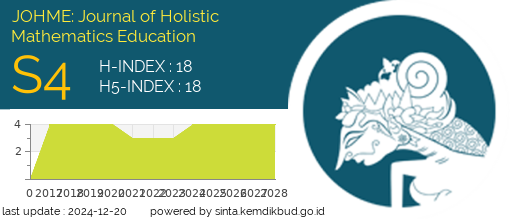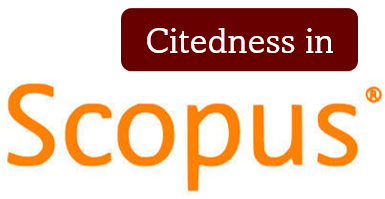HUBUNGAN ANTARA CLASSROOM ENVIRONMENT, TEACHER-STUDENT INTERPERSONAL BEHAVIOR, SERTA PRESTASI BELAJAR MAHASISWA PROGRAM STUDI MATEMATIKA [THE RELATIONSHIP BETWEEN THE CLASSROOM ENVIRONMENT AND TEACHER-STUDENT INTERPERSONAL BEHAVIOR ON THE LEARNING ACHIEVEMENT OF MATHEMATICS DEPARTMENT STUDENTS]
DOI:
https://doi.org/10.19166/johme.v3i2.2388Keywords:
Classroom environment, teacher-student interpersonal behavior, learning achievements, prestasi belajar, QTI, CUCEIAbstract
Improving learning achievement is an activity that needs to be continuously carried out by an educational institution, and it is necessary to focus on certain areas because of the many things that affect learning achievement. This study focused on the area of the classroom environment and teacher-student interpersonal behavior to see the relationship between each variable with learning achievement, and the relationship between the two variables. By using a sample of 160 X-university students majoring in mathematics and then using the Chi-Square test method with a contingency table to determine the relationship between each variable and learning achievement. Then using the Pearson correlation method the relationship between classroom environment with the teacher-student interpersonal behavior was tested. Based on the analysis and calculation of the research conducted, it can be concluded that the classroom environment has a good relationship with learning achievement in the mathematics major and general subjects. Whereas the teacher-student interpersonal behavior shows a positive relationship with learning achievement in the dimensions of leadership, understanding, and friendly/helping but a negative relationship in the dimensions of strictness and disatisfaction. In the mathematics major, the dimensions of uncertainty and admonishing are negatively related to learning achievement, but not for general subjects.
BAHASA INDONESIA ABSTRACT: Meningkatkan prestasi belajar merupakan kegiatan yang masih terus dilakukan dan berkembang, sehingga diperlukan fokus pada area tertentu. Penelitian ini terfokus pada area classroom environment dan teacher-student interpersonal behavior untuk melihat hubungan antara masing-masing variabel dengan prestasi belajar, dan hubungan antara kedua variabel. Penulis mengambil 160 sampel mahasiswa program studi matematika universitas X, kemudian menggunakan metode uji Chi-Square dengan tabel kontingensi akan dilihat hubungan antara masing-masing variabel dengan prestasi belajar. Lalu akan diuji menggunakan metode korelasi r pearson untuk melihat hubungan antara kedua variabel. Dari hasil analisa dan perhitungan penelitian yang dilakukan, dapat diambil kesimpulan Classroom Environment memiliki hubungan dengan prestasi belajar dalam mata kuliah matematika maupun umum. Sedangkan teacher-student interpersonal behavior memperlihatkan hubungan positif dengan prestasi belajar dalam dimensi leadership, understanding, dan friendly/helping serta hubungan negatif dalam dimensi dissatisfied dan strict. Pada mata kuliah matematika, dimensi uncertain dan admonishing berhubungan negatif dengan prestasi belajar, tapi tidak untuk mata kuliah umum.
References
Avianty, O., Manogu, R., & Lestari, M. M. (2018). A comparison of gender differences toward mathematics’ cognitive learning outcomes in a middle school. JOHME: Journal of Holistic Mathematics Education, 1(2), 60-68. https://doi.org/10.19166/johme.v1i2.804
Al-Fahad, F. N. (2009). Students' attitudes and perceptions towards the effectiveness of mobile learning in King Saud University, Saudi Arabia. The Turkish Online Journal of Educational Technology, 8(2), 111-119. Retrieved from http://www.tojet.net/articles/v8i2/8210.pdf
Balagova, L., & Halakova, Z. (2018). Teacher-students´interaction in comparison of teacher´s self-perception and students´ point of view. European Journal of Educational Research, 7(3), 456-472. https://doi.org/10.12973/eu-jer.7.3.465
Banjarnahor, E., Winardi, Y., & Dirgantoro, K. P. S. (2018). Hubungan antara kreativitas dengan hasil belajar kognitif siswa kelas X IPA basic SMA ABC pada pembelajaran matematika [On the relationship between creativity and cognitive learning outcomes of grade 10 basic science high school students in mathematics learning]. JOHME: Journal of Holistic Mathematics Education, 2(1), 34-44. https://doi.org/10.19166/johme.v2i1.1268
Ben-Chaim, D., & Zoller, U. (2001). Self-perception versus students' perception of teachers' personal style in college science and mathematics courses. Research in Science Education, 31, 437-454. https://doi.org/10.1023/A:1013172329170
Brophy, J. E., & Good, T. L. (2000). Looking in classrooms. New York, NY: Longman.
Clark, R. M., Kaw, A., & Besterfield-Sacre, M. (2016). Comparing the effectiveness of blended, semi-flipped, and flipped formats in an engineering numerical methods course. Advances in Engineering Education, 5(3), 1-38. Retrieved from https://files.eric.ed.gov/fulltext/EJ1122006.pdf
Clark, R. M., Besterfield-Sacre, M., Budny, D., Bursic, K. M., Clark, W. W., Norman, B. A., Parker, R. S., Patzer II, R. S., & Slaughter, W. S. (2016). Flipping engineering courses: A school wide initiative. Advances in Engineering Education, 5(3), 1-39. Retrieved from https://files.eric.ed.gov/fulltext/EJ1122004.pdf
Den, B., Fisher, D., Brekelmans, M., Rickards, T., Wubbels, T., Levy, J., & Waldrip, B. (2003). The cross national validity of students' perceptions of science teachers' interpersonal behavior. Retrieved from https://pdfs.semanticscholar.org/699c/cff2498e4eec297d0abfde6a32439c406797.pdf?_ga=2.154822332.540394798.1588753124-324465319.1588558769
Den, B., Levy, J., Brekelmans, M., & Wubbels, T. (2005). The effect of teacher interpersonal behavior on students' subject-specific motivation for ESQL. The Journal of Classroom Interaction, 40, 20-33. Retrieved from https://www.researchgate.net/publication/46675971_The_effect_of_teacher_interpersonal_behaviour_on_students'_subject-specific_motivation/link/00b7d53b3fac92156f000000/download
Djuarsa, R. N., Wulanata, I. A., & Hidayat, D. (2017). Hubungan motivasi belajar siswa dengan persepsi siswa dalam berprestasi [The relationship between students' motivation and students' perceptions of achievement]. Polyglot: Jurnal Ilmiah, 13(1), 21-34. https://doi.org/10.19166/pji.v13i1.349
Fisher, D., Fraser, B., & Cresswell, J. (1995). Using the "Questionnaire on teacher interaction" in the professional development of teachers. Australian Journal of Teacher Education, 20(1), 8-19. https://doi.org/10.14221/ajte.1995v20n1.2
Fraser, B. J. (1987). A comparison of the psychosocial climate of different types of schools. Annual Meeting of the American Educational Research Association. Retrieved from http://files.eric.ed.gov/fulltext/ED282727.pdf
Fraser, B. J. (2011). Classroom environment (Vol. 4). London, UK: Routledge.
Fraser, B. J. (n. d.). 5.1 science learning environments: Assessment, effects and determinants. Retrieved from https://surveylearning.moodle.com/cles/papers/Handbook98.htm
Fraser, B., & Pickett, L. (2010). Creating and assessing positive classroom learning environments. Childhood Education, 86, 321-326. https://doi.org/10.1080/00094056.2010.10521418
Henderson, D., Fisher, D. L., & Fraser, B. J. (2000). Interpersonal behavior, laboratory learning environments, and student outcomes in senior biology classes. Journal of Research in Science Teaching, 37(1), 26-43. https://doi.org/10.1002/(sici)1098-2736(200001)37:1<26::aid-tea3>3.0.co;2-i
Ly, R., & Malone, J. (2010). Teachers' perception of geometry instruction and the learning environment in year 9-10 ESL classrooms. Shaping the future of mathematics education: Proceedings of the 33rd annual conference of the mathematics education research group of Australasia. https://files.eric.ed.gov/fulltext/ED520927.pdf
Markey, P. M., Funder, D. C., & Ozer, D. J. (2003). Complementarity of interpersonal behaviors in dyadic interactions. Personality and Social Psychology Bulletin, 29(9), 1082-1090. https://doi.org/10.1177/0146167203253474
NeSmith, R. A. (2005). Are student perceptions of teaching an important variable that influences student achievement. Spectrum: The Journal of the Illinois Science Teachers Association, 31(1), 19-25. Retrieved from https://www.academia.edu/1962287/Are_student_perceptions_of_teaching_an_important_variable_that_influences_student_achievement
Ramsley, D. G. (1997). Associations between classroom learning environments, teacher interpersonal behaviour and student outcomes in secondary mathematics classrooms. Science and Mathematics Education Centre. https://espace.curtin.edu.au/bitstream/handle/20.500.11937/1950/10959_Rawnsley%20D%201997.pdf?sequence=2&isAllowed=y
Rosenshine, B. (1976). Recent research on teaching behaviors and student achievement. Journal of Teacher Education, 27(1), 61-64. https://doi.org/10.1177/002248717602700115
Sudjana. (1989). Metoda statistika. Bandung, Indonesia: Tarsito.
Sufren, & Natanael, Y. (2013). Mahir menggunakan SPSS secara otodidak. Jakarta, Indonesia: PT. Elex Media Komputindo.
Telli, S., den Brok, P., & Cakiroglu, T. (2008). Teacher-student interpersonal behavior in secondary science classes in Turkey. The Journal of Classroom Interaction, 42(2), 31-40. Retrieved from https://www.jstor.org/stable/23869791?seq=1
Treagust, D. F., & Fraser, B. J. (1986). Validation and application of the college and university classroom environment inventory (CUCEI). Retrieved from https://files.eric.ed.gov/fulltext/ED274692.pdf
Wilson-Fleming, L., & Wilson-Younger, D. (2012). Positive classroom environments = Positive academic results. Retrieved from https://files.eric.ed.gov/fulltext/ED536465.pdf
Wubbels, T. (1993). Teacher-student relationships in science and mathematics classes. What research says to the science and mathematics teacher. Number 11. Retrieved from https://files.eric.ed.gov/fulltext/ED373957.pdf
Wubbels, T., Creton, H., & Hooymayers, H. (1985). Discipline problems of beginning teachers, interactional teacher behaviour mapped out. Retrieved from https://files.eric.ed.gov/fulltext/ED260040.pdf
Wubbels, T., Creton, H., & Hooymayers, H. (1992). Review of research on teacher communication styles with use of the Leary model. Journal of Classroom Interaction, 27(1), 1-11. Retrieved from https://www.jstor.org/stable/23869397?seq=1Downloads
Published
How to Cite
Issue
Section
License
Authors who publish with this journal agree to the following terms:
1) Authors retain copyright and grant the journal right of first publication with the work simultaneously licensed under a Creative Commons Attribution License (CC-BY-SA 4.0) that allows others to share the work with an acknowledgement of the work's authorship and initial publication in this journal.
2) Authors are able to enter into separate, additional contractual arrangements for the non-exclusive distribution of the journal's published version of the work (e.g., post it to an institutional repository or publish it in a book), with an acknowledgement of its initial publication in this journal.
3) Authors are permitted and encouraged to post their work online (e.g., in institutional repositories or on their website). The final published PDF should be used and bibliographic details that credit the publication in this journal should be included.”










